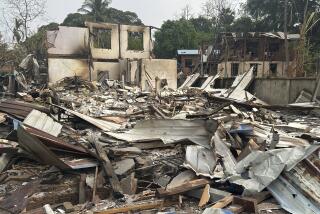Battered and Hungry, Laotian Rebels Continue to Fight
- Share via
BANGKOK, Thailand — When half a dozen gunmen attacked a Laotian border checkpoint this summer, their supporters declared it the beginning of a new campaign to topple Laos’ communist government.
Every week, sympathizers issue dispatches describing military actions they claim to have taken. The attackers style themselves as members of the hitherto unknown Lao Citizen Movement for Democracy and say they are carrying out a new “revolution” against communism.
But “desperation” seems a better word to characterize the attack on the border checkpoint in northwestern Laos the morning of July 12 in which some duty-free shops were shot up and a 12-year-old boy was slightly wounded.
Despite the bravado, the rebels are really yesterday’s warriors, fighting their final battles in a distant echo of the Vietnam War that ended in 1975.
In a fight no one expects them to win, the rebels are, for the most part, members of Laos’ ethnic Hmong minority, hill dwellers who backed the losing side -- the Americans -- in the conflict that engulfed the countries of Indochina: Vietnam, Cambodia and Laos.
“I suppose it could be described as the tail end of an insurgency that the remnants of the ‘secret army’ Hmong who stayed in Laos after 1975 thought they could still mount against the Lao regime,” Martin Stuart-Fox, a Laos scholar at Australia’s University of Queensland, said in an e-mail interview. “It hardly has the amplitude or support base to count as a full-blown insurgency.”
The Hmong spearheaded American efforts to keep the communist Pathet Lao at bay during the Vietnam conflict. The ineffectual Royal Lao Army was loath to take to the battlefield, so the CIA enlisted the Hmong -- tough tribal people from the harsh countryside -- to fight the communists.
But the U.S. gave up the war in 1975 and, one by one, the capitals of Indochina fell to communist forces.
After the dramatic seizures of Phnom Penh in Cambodia and Saigon in Vietnam, the Pathet Lao took over the Laotian capital, Vientiane, unopposed, and renamed the kingdom the Lao People’s Democratic Republic.
More than 300,000 Laotian refugees, mostly Hmong, fled after the takeover, many eventually resettling in the United States.
But other Hmong stayed behind to face their fate, or carry on the fight -- alone this time.
In 1982-83, allegations that chemical weapons were being used by the Laotian government against Hmong rebels briefly put their situation back in the spotlight. The allegations were never resolved, but supporters of the Hmong believe that such tactics are still being used.
Few outsiders -- aside from the Hmong diaspora -- knew or cared about what was happening in Laos. The major problem was a lack of reliable information because of the remoteness of the country and the secretive nature of its communist regime.
Unverifiable accounts of atrocities trickled out to the Hmong community in the United States. Between 2,000 and 10,000 Hmong rebels were believed active, but in ever more desperate conditions that saw them and their families under siege or on the run.
Late last year, two journalists for Time magazine’s Asia edition journeyed to Laos and reported that the Hmong community is dwindling and under siege by the communist government. They did not witness any fighting, but described miserable living conditions and scabrous wounds on many Hmong.
Other journalists who reached the area also reported that the Hmong were desperate after hiding for years in the jungle, waiting in vain for the Americans to return.
Earlier this year, a semiretired American couple, Ed and Georgie Szendrey, who had become interested in the cause through contacts with the Hmong community in their hometown of Oroville, Calif., helped open the information pipeline.
The couple worked with Hmong refugees to establish what amounted to a private intelligence service and news agency. They smuggled satellite phones and video cameras into Laos and had tapes of the Hmongs’ situation smuggled out. What was revealed was pitiful: adults disfigured by war and disease, and children starving and crippled.
Like others who have embraced the issue, the Szendreys believe that the United States owes a debt to the Hmong. “I don’t know if I feel guilt as much as I do deep concern that we take responsibility for what we left behind,” Szendrey said.
Human rights workers say the Hmong are facing a persistent onslaught by the communist government.
“Many, if not all, of the group may be at risk of extrajudicial execution by the Lao authorities who publicly refer to them and other similar groups as ‘bandits,’ ” said Amnesty International, the London-based human rights group.
In an interview, Amnesty researcher Daniel Alberman was blunt. The Hmong rebels, he said, “appear to be being hunted down like animals.”
More to Read
Sign up for Essential California
The most important California stories and recommendations in your inbox every morning.
You may occasionally receive promotional content from the Los Angeles Times.













